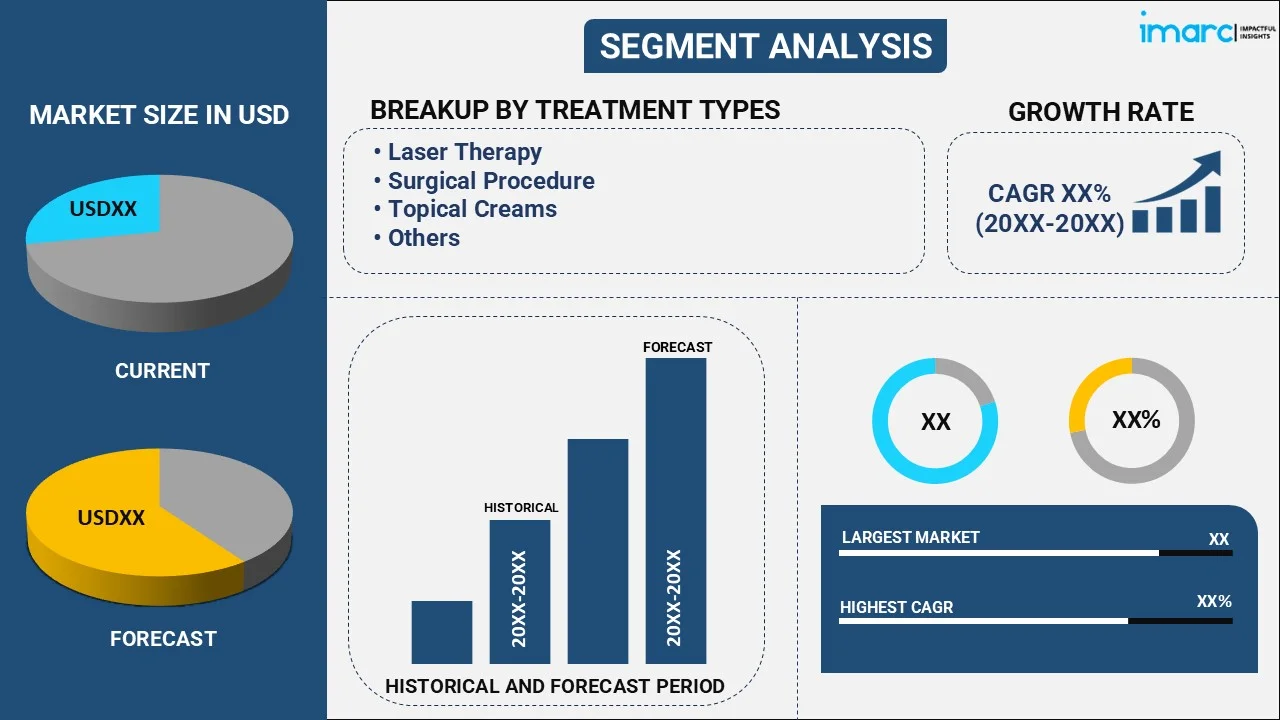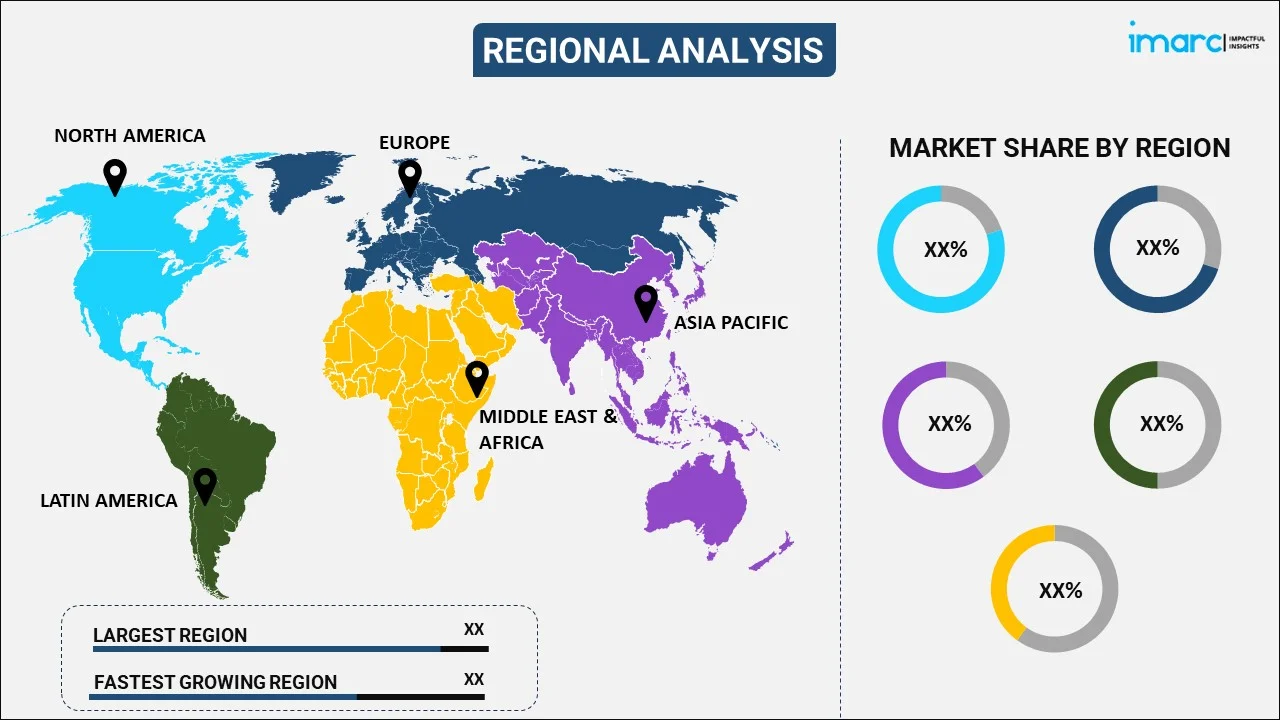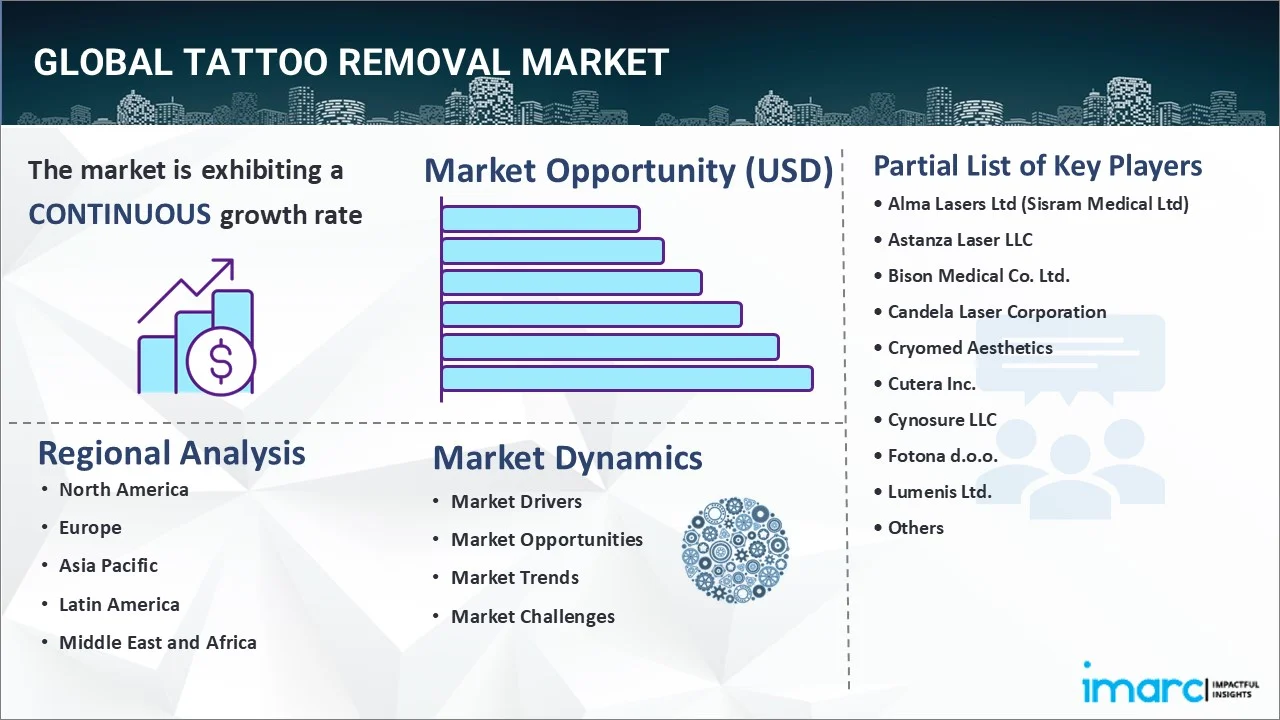
Tattoo Removal Market Report by Treatment Type (Laser Therapy, Surgical Procedure, Topical Creams, and Others), End User (Hospitals, Clinics, and Others), and Region 2025-2033
Tattoo Removal Market Size:
The global tattoo removal market size reached USD 307.2 Million in 2024. Looking forward, IMARC Group expects the market to reach USD 545.1 Million by 2033, exhibiting a growth rate (CAGR) of 6.6% during 2025-2033. Continuous innovations in laser technology, increasing tattoo regret, higher disposable incomes, changing aesthetic preferences, professional standards, greater awareness of the safety factor, regulatory support, and the growing popularity of tattoo modifications or cover-ups are some of the key factors influencing market growth.
|
Report Attribute
|
Key Statistics
|
|---|---|
|
Base Year
|
2024
|
|
Forecast Years
|
2025-2033
|
|
Historical Years
|
2019-2024
|
|
Market Size in 2024
|
USD 307.2 Million |
|
Market Forecast in 2033
|
USD 545.1 Million |
| Market Growth Rate 2025-2033 | 6.6% |
Tattoo Removal Market Analysis:
- Major Market Drivers: Significant advancement in laser technology, increasing tattoo regret, and higher disposable income are the leading drivers of the tattoo removal market. In confluence with this, shifts in aesthetic preference and professional standards driving demand for more efficient and less painful options for removal are strengthening the market growth.
- Key Market Trends: Innovations like Q-switched and picosecond lasers are key trends that have brought about higher removal efficiency and fewer side effects. In addition to this, enhanced acceptance by society of tattoo modifications and increasing awareness of safety and efficacy in the modern techniques of removal are impelling the market.
- Geographical Trends: High prevalence, coupled with changing cultural norms and a strong healthcare infrastructure, underpins significant demand for tattoo removal services in North America. Moreover, advanced technologies present in the region, combined with skilled practitioners working within them, further avail tattoo removal procedures to a wider population demographic.
- Competitive Landscape: Some of the major market players in the tattoo removal industry include Alma Lasers Ltd (Sisram Medical Ltd), Astanza Laser LLC, Bison Medical Co. Ltd., Candela Laser Corporation, Cryomed Aesthetics, Cutera Inc., Cynosure LLC, Fotona d.o.o., Lumenis Ltd., Lutronic Corporation, Quanta System S.p.A., The Global Beauty Group, among many others.
- Challenges and Opportunities: The tattoo removal market is still riddled with high costs for advanced laser treatments and possible side effects, which is creating hurdles for market expansion. However, the development of more pocket-friendly and effective technologies making professional services more accessible, and building general awareness about safe removal options are presenting lucrative opportunities for market growth.
Tattoo Removal Market Trends:
Technological Advancements in Removal Techniques
Technological innovations have revolutionized the tattoo removal market, making procedures more efficient, less painful, and with fewer side effects. The introduction of advanced laser technologies, such as Q-switched lasers, picosecond lasers, and fractional lasers, has significantly improved the removal process. Q-switched lasers emit high-intensity pulses in short durations, effectively breaking down the tattoo pigments without damaging the surrounding skin. Picosecond lasers, operating at an even faster rate, have further enhanced the removal process by targeting smaller pigment particles with greater precision, resulting in faster and more complete removal with fewer treatment sessions. Additionally, the development of fractional lasers, which create micro-injuries in the skin to promote natural healing and pigment dispersion, has broadened the range of removable tattoo types and colors, driving the market growth.
Increasing Social Acceptance and Demand for Tattoo Modifications
The growing social acceptance of tattoos has positively impacted the demand for tattoo removal. As more people get inked, there’s been a correspondingly rise in tattoo regrets or, the desire for modifications. This mostly involves tattoo removal or alteration where such body art does not represent the present identity, lifestyle, or aesthetic taste of the individual. This can also be attributed to the rise in professional and personal standards; people may opt for removal to better their job prospects or just to fit into social and cultural circles. The other budding trend includes the concept of "cover-up tattoos," which means getting a new design over the older one, and most methods involve the partial or complete removal of the old tattoo. This trend is fueling the demand for the removal service.
Rising Awareness of Tattoo Removal Safety and Efficacy
Public awareness regarding the safety and efficiency of modern techniques in tattoo removal has hugely improved, strengthening the market growth. Education campaigns, advertising by clinics on removals, and endorsements from medical professionals all cite development and minimized risks found in procedures today. As such, potential clients would be more confident to undergo such procedures knowing it would be with minimal scares and side effects. The increasing availability of information through the internet and social media has also contributed, as it allows people to ask and share their own experiences in relation to tattoo removal. This escalating awareness dissipated the mystery surrounding the process along with the fears, which motivated people to venture into the tattoo removal business.
Tattoo Removal Market Segmentation:
IMARC Group provides an analysis of the key trends in each segment of the market, along with forecasts at the global, regional, and country levels for 2025-2033. Our report has categorized the market based on treatment type and end user.
Breakup by Treatment Type:

- Laser Therapy
- Surgical Procedure
- Topical Creams
- Others
Laser therapy accounts for the majority of the market share
The report has provided a detailed breakup and analysis of the market based on the treatment type. This includes laser therapy, surgical procedure, topical creams, and others. According to the report, laser therapy represented the largest segment.
Based on the tattoo removal market research report, the demand for laser therapy is driven by its precision, minimal invasiveness, and reduced recovery time compared with traditional methods. Laser therapy works specifically, since different colors of pigment break down under specific wavelengths, hence being suitable for very different tattoo types and skin tones. Since laser treatment is relatively less invasive, there is also a lower risk of infections and resultant scarring—making it more attractive to those seeking a safer alternative. Besides, with continuous laser improvements, the sessions required have reduced in number for complete removal. Furthermore, treatment plans customized to tattoo size, color, and age making it all the more attractive for various results are propelling the market forward.
Breakup by End User:
- Hospitals
- Clinics
- Others
Hospitals represent the leading market segment
The report has provided a detailed breakup and analysis of the market based on the end user. This includes hospitals, clinics, and others. According to the report, hospitals represented the largest segment.
The tattoo removal market analysis shows that the demand for tattoo removal services in hospitals is driven by the assurance of medical-grade safety and comprehensive care provided in a clinical setting. Hospitals are equipped with advanced medical equipment and staffed by certified dermatologists and trained medical personnel, which ensures a higher standard of safety and professionalism. Patients often prefer hospitals for tattoo removal due to the rigorous sterilization protocols and the availability of immediate medical intervention if complications arise. Additionally, hospitals can offer a multidisciplinary approach to tattoo removal, addressing any underlying skin conditions or complications that may accompany the procedure. The credibility and trust associated with hospital settings make them an attractive option for individuals seeking reliable and effective tattoo removal services, thus creating a positive outlook for market expansion.
Breakup by Region:

- North America
- United States
- Canada
- Asia-Pacific
- China
- Japan
- India
- South Korea
- Australia
- Indonesia
- Others
- Europe
- Germany
- France
- United Kingdom
- Italy
- Spain
- Russia
- Others
- Latin America
- Brazil
- Mexico
- Others
- Middle East and Africa
North America leads the market, accounting for the largest tattoo removal market share
The report has also provided a comprehensive analysis of all the major regional markets, which include North America (the United States and Canada); Asia Pacific (China, Japan, India, South Korea, Australia, Indonesia, and others); Europe (Germany, France, the United Kingdom, Italy, Spain, Russia, and others); Latin America (Brazil, Mexico, and others); and the Middle East and Africa. According to the report, North America represents the largest regional market for tattoo removal.
The demand for tattoo removal in North America is driven by the high prevalence of tattoos, leading to a substantial number of individuals seeking modifications or complete removal. The cultural dynamics in North America, with evolving trends and shifting personal and professional standards, contribute significantly to this demand. The region's strong focus on aesthetics and personal appearance, coupled with the influence of social media and celebrity culture, encourages individuals to reassess their tattoos, often opting for removal or alterations. Additionally, North America boasts a robust healthcare infrastructure, with widespread access to advanced tattoo removal technologies and skilled practitioners, making the process more accessible and appealing.
Competitive Landscape:
- The market research report has also provided a comprehensive analysis of the competitive landscape in the market. Detailed profiles of all major companies have also been provided. Some of the major market players in the tattoo removal industry include Alma Lasers Ltd (Sisram Medical Ltd), Astanza Laser LLC, Bison Medical Co. Ltd., Candela Laser Corporation, Cryomed Aesthetics, Cutera Inc., Cynosure LLC, Fotona d.o.o., Lumenis Ltd., Lutronic Corporation, Quanta System S.p.A., The Global Beauty Group, etc.
(Please note that this is only a partial list of the key players, and the complete list is provided in the report.)
- The competitive landscape of the global tattoo removal market is characterized by a mix of established medical device companies, specialized clinics, and emerging technology firms, all vying for market share through innovation and strategic partnerships. Key players dominate with advanced laser technologies and extensive distribution networks, offering cutting-edge solutions that set industry standards. Specialized tattoo removal clinics emphasize personalized services and state-of-the-art equipment to attract clientele seeking expert care. New entrants focus on developing novel techniques and devices, such as picosecond lasers, to capture market segments seeking faster and more efficient treatments. The market is also witnessing strategic collaborations and acquisitions aimed at expanding technological capabilities and geographic reach.
Tattoo Removal Market News:
- In January 2024, Cynosure and Lutronic announced a merger agreement to create a leading global medical aesthetics technology company. The strategic combination of Cynosure and Lutronic will create a global leader in medical aesthetic systems with a diversified product portfolio and a commercial presence in over 130 countries.
- In April 2023, Alma Lasers (Israel) introduced the Harmony XL Pro+ tattoo removal device. This state-of-the-art gadget erased tattoos precisely and successfully by employing various laser wavelengths and cutting-edge
Tattoo Removal Market Report Scope:
| Report Features | Details |
|---|---|
| Base Year of the Analysis | 2024 |
| Historical Period | 2019-2024 |
| Forecast Period | 2025-2033 |
| Units | Million USD |
| Scope of the Report | Exploration of Historical Trends and Market Outlook, Industry Catalysts and Challenges, Segment-Wise Historical and Future Market Assessment:
|
| Treatment Types Covered | Laser Therapy, Surgical Procedure, Topical Creams, Others |
| End Users Covered | Hospitals, Clinics, Others |
| Regions Covered | Asia Pacific, Europe, North America, Latin America, Middle East and Africa |
| Countries Covered | United States, Canada, Germany, France, United Kingdom, Italy, Spain, Russia, China, Japan, India, South Korea, Australia, Indonesia, Brazil, Mexico |
| Companies Covered | Alma Lasers Ltd (Sisram Medical Ltd), Astanza Laser LLC, Bison Medical Co. Ltd., Candela Laser Corporation, Cryomed Aesthetics, Cutera Inc., Cynosure LLC, Fotona d.o.o., Lumenis Ltd., Lutronic Corporation, Quanta System S.p.A., The Global Beauty Group, etc. |
| Customization Scope | 10% Free Customization |
| Post-Sale Analyst Support | 10-12 Weeks |
| Delivery Format | PDF and Excel through Email (We can also provide the editable version of the report in PPT/Word format on special request) |
Key Benefits for Stakeholders:
- IMARC’s industry report offers a comprehensive quantitative analysis of various market segments, historical and current market trends, market forecasts, and dynamics of the tattoo removal market from 2019-2033.
- The research report provides the latest information on the market drivers, challenges, and opportunities in the global tattoo removal market.
- The study maps the leading, as well as the fastest-growing, regional markets. It further enables stakeholders to identify the key country-level markets within each region.
- Porter's five forces analysis assists stakeholders in assessing the impact of new entrants, competitive rivalry, supplier power, buyer power, and the threat of substitution. It helps stakeholders to analyze the level of competition within the tattoo removal industry and its attractiveness.
- The competitive landscape allows stakeholders to understand their competitive environment and provides insight into the current positions of key players in the market.
Key Questions Answered in This Report
The global tattoo removal market was valued at USD 307.2 Million in 2024.
We expect the global tattoo removal market to exhibit a CAGR of 6.6% during 2025-2033.
The high prevalence of tattoo-induced skin disorders, such as sarcoidosis and lupus-like reactions, along with the growing popularity of non-invasive procedures for tattoo removal with less pain and no downtime, is primarily driving the global tattoo removal market.
The sudden outbreak of the COVID-19 pandemic had led to the postponement of tattoo removal procedures to reduce the risk of the coronavirus infection upon hospital visits, thereby negatively impacting the demand for the tattoo removal process.
Based on the treatment type, the global tattoo removal market has been segmented into laser therapy, surgical procedure, topical creams, and others. Among these, laser therapy currently represents the largest market share.
Based on the end user, the global tattoo removal market can be bifurcated into hospitals, clinics, and others. Currently, hospitals account for the majority of the total market share.
On a regional level, the market has been classified into North America, Europe, Asia-Pacific, Middle East and Africa, and Latin America, where North America currently dominates the global market.
Some of the major players in the global tattoo removal market include Alma Lasers Ltd (Sisram Medical Ltd), Astanza Laser LLC, Bison Medical Co. Ltd., Candela Laser Corporation, Cryomed Aesthetics, Cutera Inc., Cynosure LLC, Fotona d.o.o., Lumenis Ltd., Lutronic Corporation, Quanta System S.p.A., and The Global Beauty Group.
Need more help?
- Speak to our experienced analysts for insights on the current market scenarios.
- Include additional segments and countries to customize the report as per your requirement.
- Gain an unparalleled competitive advantage in your domain by understanding how to utilize the report and positively impacting your operations and revenue.
- For further assistance, please connect with our analysts.

 Request Customization
Request Customization
 Speak to an Analyst
Speak to an Analyst
 Request Brochure
Request Brochure
 Inquire Before Buying
Inquire Before Buying




.webp)




.webp)












